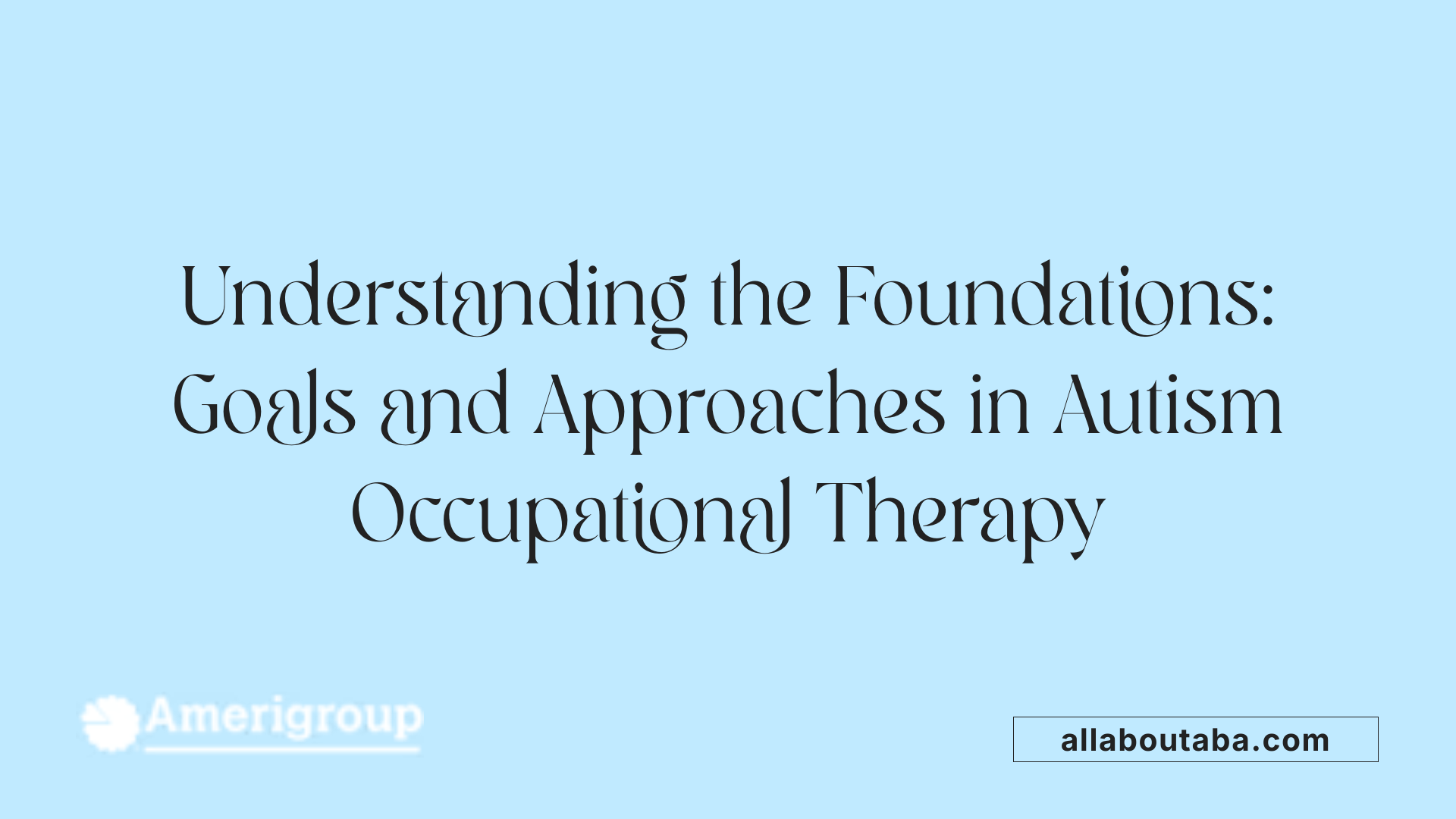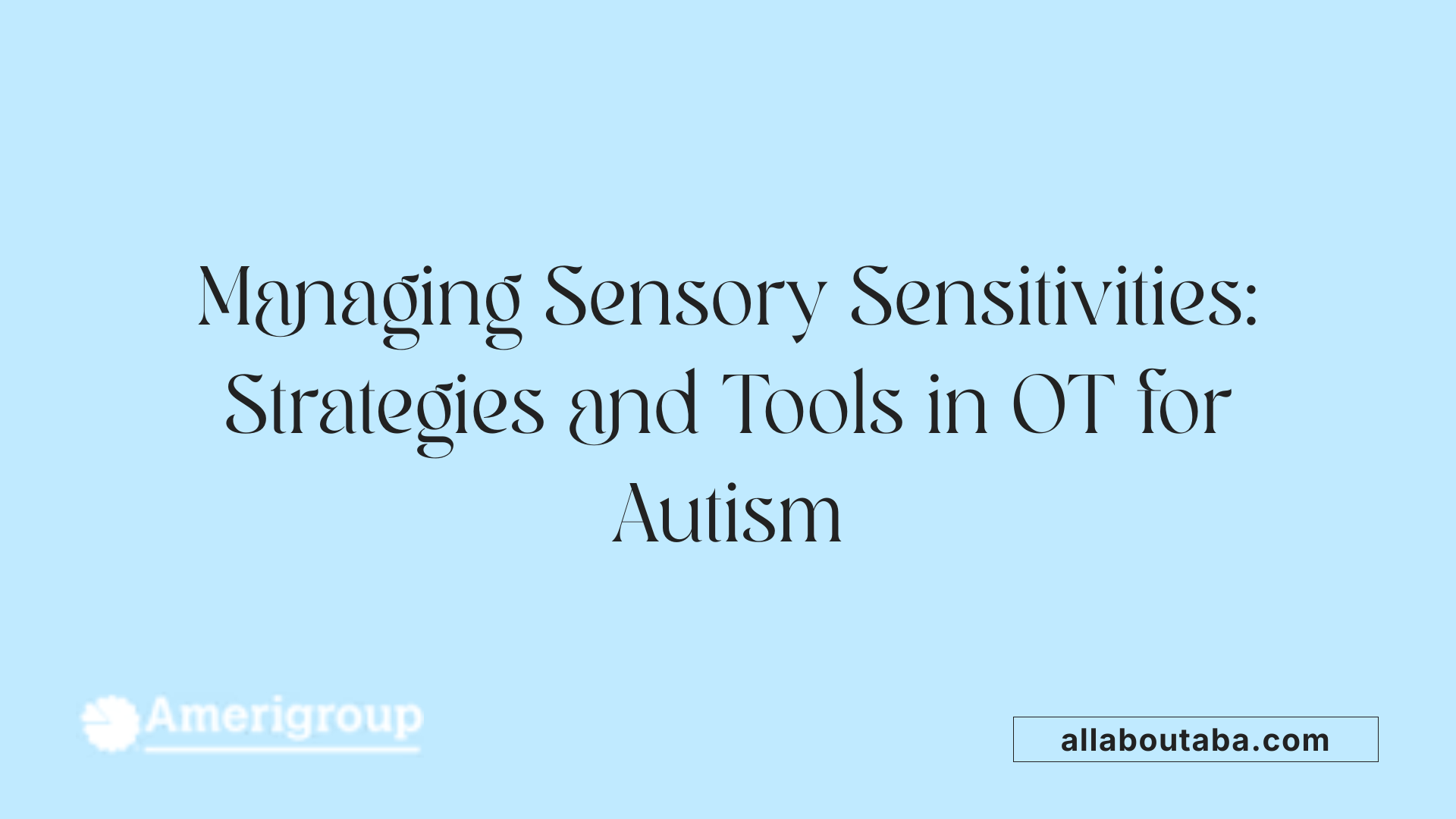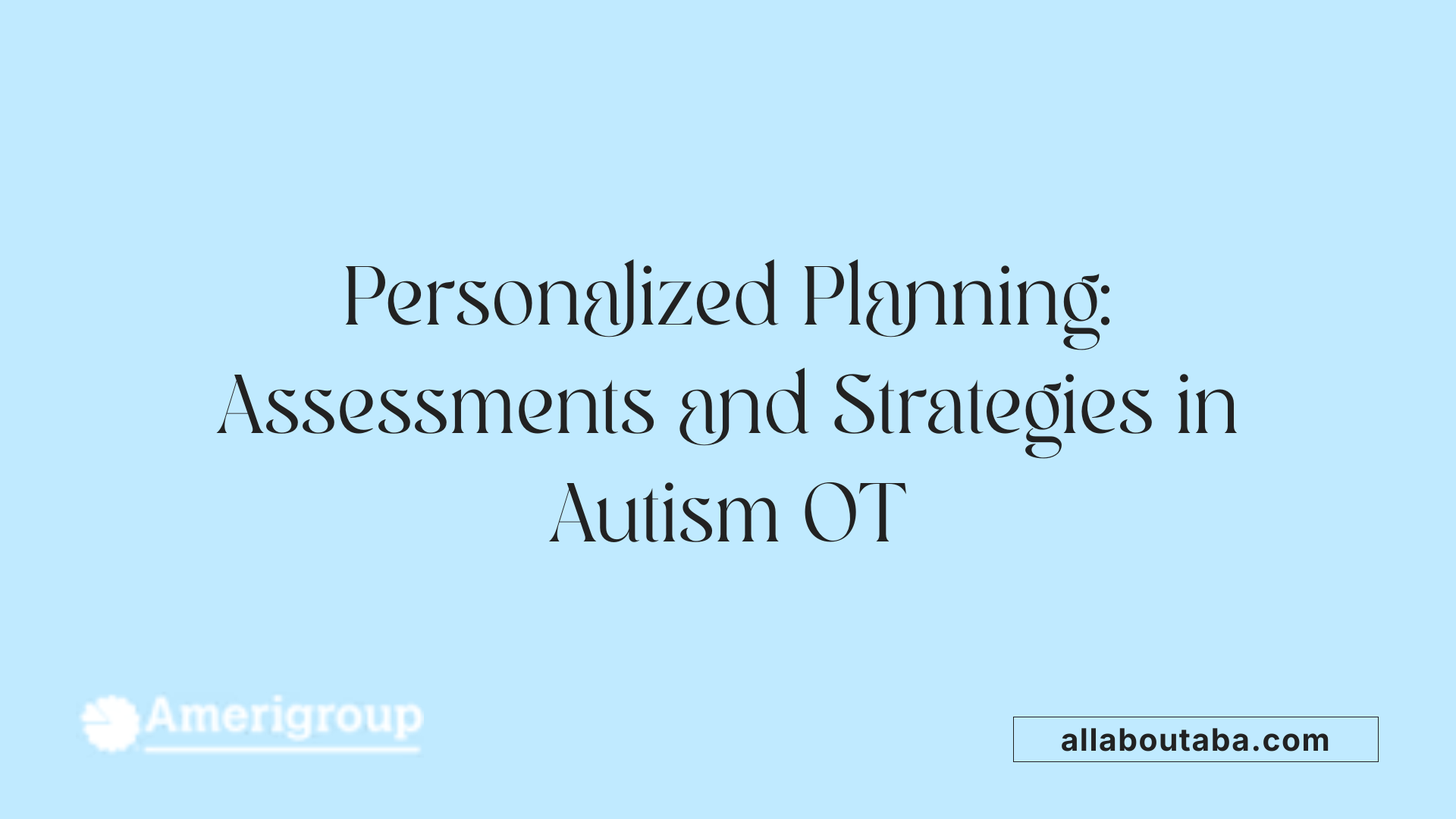Understanding the Intersection of Occupational Therapy and Autism Transitions
Transition planning for individuals with Autism Spectrum Disorder (ASD) is a critical process that ensures continued growth, independence, and participation in meaningful life activities. Occupational therapy (OT) plays an essential role in this planning by addressing sensory challenges, promoting self-determination, and facilitating adaptation during changes in environments and routines. This article explores how occupational therapy supports smooth and empowering transitions for those on the autism spectrum, emphasizing evidence-based strategies, new technologies, and interdisciplinary collaborations.
Foundations of Occupational Therapy in Autism Support

What are the goals of occupational therapy for children with ASD?
Occupational therapy for children with Autism Spectrum Disorder (ASD) aims to enhance their independence and participation in daily life. Goals include helping children understand personal boundaries, improving social participation, and fostering safety awareness. Therapists focus on developing essential daily living skills such as brushing teeth, bathing, and dressing. They also create structured schedules to support smooth transitions, encourage emotional regulation, and address challenges like food selectivity.
How is occupational therapy individualized and play-based?
Occupational therapy for children with ASD uses an individualized and play-based approach. Each therapy plan is tailored to the child’s unique strengths, needs, and preferences. By embedding learning within play and meaningful activities, therapists promote engagement and motivation. This holistic method considers the child's sensory sensitivities, communication styles, and environmental factors, enabling the child to develop skills in authentic contexts.
Why is involving caregivers and maintaining consistency important?
Active involvement of caregivers is essential to reinforce therapy gains beyond the clinical setting. Occupational therapists guide caregivers in applying strategies consistently across home, school, and community environments. This collaboration ensures that therapeutic interventions are integrated into daily routines, offering stability and predictability that support a child's development. Consistency also helps children generalize skills and better manage their sensory and emotional experiences.
Sensory Challenges in Autism and OT Interventions

What Are Sensory Modulation Difficulties in ASD?
Children with Autism Spectrum Disorder (ASD) often face sensory modulation challenges, meaning they struggle to process and respond appropriately to sensory stimuli. This can affect how they perceive sight, sound, touch, taste, smell, body position, and balance. Such sensory sensitivities can make routine activities more difficult and distressing.
How Do Occupational Therapists Address These Sensory Issues?
Occupational therapists (OTs) use a variety of sensory integration strategies designed to help children with ASD manage their sensory responses more effectively. These approaches often include play-based activities and structured sensory experiences tailored to each child's unique sensory profile.
What Tools Are Commonly Used in Sensory Regulation?
To support regulation of sensory input, OTs often incorporate specialized equipment:
- Weighted Blankets: Provide deep pressure stimulation that can help calm the nervous system.
- Pressure Vests: Offer consistent proprioceptive input to promote body awareness and a sense of security.
- Noise-Canceling Headphones: Reduce overwhelming auditory stimuli in noisy environments, aiding concentration and reducing anxiety.
By using these strategies and tools, occupational therapy helps children with ASD access their environments more comfortably, increase independence, and participate in meaningful daily activities.
Use of New Technologies in Occupational Therapy for Autism

What Technology Types Are Used in Occupational Therapy for Autism?
Occupational therapy (OT) interventions for children and adolescents with Autism Spectrum Disorder (ASD) commonly incorporate technology to support learning and engagement. Computers and iPads are the most frequently utilized devices. Their popularity stems from their broad availability and the comfort level many children with ASD have with these tools.
What Are Some Emerging Technologies in This Field?
Beyond conventional devices, emerging technologies are being explored though less widely used. Examples include assistive robots that can help with social skills and communication, and augmented reality (AR), which offers interactive, immersive environments to practice daily living skills and cognitive tasks.
What Positive Outcomes Have Been Observed from Technology-Enhanced Interventions?
Technology-enhanced OT interventions have demonstrated improvements in several critical areas:
- Activities of daily living (ADLs), such as dressing and grooming
- Social skills, including communication and interaction
- Motor control and coordination
- Visual-perceptual abilities
- Overall communication skills
These positive outcomes highlight how integrating technology into OT programs can enhance participation, independence, and development for children with ASD.
Multidisciplinary and Goal-Oriented OT Interventions

How do occupational therapists collaborate with other professionals in ASD intervention?
Occupational therapists (OTs) frequently work within multidisciplinary teams to provide holistic support for children with Autism Spectrum Disorder (ASD). These collaborations integrate expertise from healthcare providers, educators, caregivers, and therapists to address diverse developmental needs comprehensively. This joint effort ensures that interventions are consistent and tailored across different environments such as home, school, and community.
What role do environmental adaptations and caregiver coaching play?
Environmental adaptations are a cornerstone of OT interventions. Modifications might include visual supports like schedules and transition cards or sensory accommodations to regulate input, enhancing participation and comfort. Caregiver coaching complements these adaptations by empowering families with strategies to implement therapeutic goals daily, thereby ensuring continuity and reinforcing progress outside therapy sessions.
How do strengths-based language and trauma-informed practices enhance service delivery?
OTs are increasingly adopting strengths-based language, emphasizing individual capabilities rather than limitations. This approach fosters self-efficacy and engagement while promoting dignity and respect. Integrated with trauma-informed practices, which recognize and respond to potential traumatic experiences, these methods create safe and supportive environments, enhancing the effectiveness of interventions and facilitating emotional regulation and trust-building.
These multidisciplinary, individualized strategies align with evidence supporting improved occupational outcomes and participation, highlighting the essential role of occupational therapy in supporting children with ASD throughout their transitions and daily lives.
Assessment and Personalized Planning in Occupational Therapy

Comprehensive Evaluation Tailored to ASD
Occupational therapy for children with Autism Spectrum Disorder (ASD) begins with a comprehensive, individualized evaluation designed to understand each child's unique abilities, challenges, and environments. This assessment includes examining daily occupations and performance skills, as well as contextual factors influencing function. Many adaptations are made to suit the specific needs of children with ASD, ensuring that evaluations capture sensory sensitivities, communication preferences, and social participation levels. This tailored approach allows therapists to identify interventions that foster meaningful engagement in routines and activities.
Occupational Profiles and Emotional Impact Analysis
A vital component of assessment is creating occupational profiles that delve into a child's feelings and emotional responses. Occupational therapists explore how emotions influence roles, routines, and participation, especially during transitions that can be challenging for autistic individuals. By analyzing the emotional impact, therapists can integrate strategies such as coping mechanisms and emotional regulation into intervention plans. These profiles contribute to holistic, play-based therapy that aligns with the child’s preferences and strengths.
Assessment of Social Determinants of Health
Occupational therapists also evaluate social determinants of health to identify barriers affecting participation and well-being. This assessment is particularly important for discharge planning and community reintegration. Factors like family support, access to resources, and environmental influences are considered to craft personalized plans that promote inclusion and independence. Utilizing models like the KAWA model helps therapists understand the interactive effect of environmental assets and barriers, further informing transition strategies.
Together, these assessment methods guide occupational therapists in designing effective, strength-based and trauma-informed plans that enhance the participation, safety, and development of children with ASD across their life stages.
The PEO Model in Transition Planning for Autism
What is the Person-Environment-Occupation (PEO) Model?
The PEO model in occupational therapy recognizes the dynamic interaction between three critical components: the person, their environment, and their occupations (daily activities). This framework helps therapists understand how these elements influence each other and jointly affect an individual's ability to participate successfully in various life transitions.
How Are Environmental Modifications Used?
In transition planning for children and adults with autism, occupational therapists apply the PEO model by tailoring the environment to better support participation. Visual cues such as schedules, timers, and transition cards are common modifications. These tools provide clear, predictable information that helps individuals anticipate and adjust to changes smoothly.
What Support Systems Facilitate Smooth Transitions?
Support systems are vital for effective transitions. Occupational therapists encourage the use of tailored support networks including family, educators, and caregivers. They also introduce tangible aids like 'finished' boxes to signal task completion and strategies promoting coping and emotional regulation. These supports create a stable and reassuring environment.
By addressing the interplay of person, environment, and occupation, the PEO model guides occupational therapists in designing interventions that foster independence and resilience during life's transitions for people on the autism spectrum.
Strategies for Supporting Transitions in Autism
How do occupational therapists prepare children with autism for transitions?
Occupational therapists use a variety of preparation tools to support children on the autism spectrum during transitions. Visual timers and schedules are common aids, providing clear and concrete representations of time and upcoming activities. These tools help reduce anxiety and increase predictability by outlining what to expect next.
What are the phases of transition and why is understanding them important?
Transitions are understood in three phases: endings, the neutral zone, and new beginnings. Endings involve letting go of old routines or roles. The neutral zone is a period of uncertainty and adjustment, while new beginnings mark the establishment of new routines and roles. Recognizing these phases helps therapists tailor their strategies to support emotional regulation, coping, and engagement throughout the change process.
How are tangible tools like 'finished' boxes used in transitions?
Tangible tools such as a 'finished' box serve as concrete signals that an activity has ended. This aids children who may struggle with abstract concepts of time or task completion. Using such tools creates consistency and clarity, which are vital for managing transitions smoothly and fostering a sense of accomplishment.
Together, these strategies form a comprehensive framework that occupational therapists employ to facilitate smoother, less stressful transitions for autistic children, enhancing their participation and well-being.
Emotional Regulation and Coping in Transition Planning
How Do Occupational Therapists Support Emotional Regulation?
Occupational therapists (OTs) use a variety of techniques to help children with Autism Spectrum Disorder (ASD) regulate their emotions, especially during transitions. These include sensory-integration strategies, where tools like weighted blankets and pressure vests provide calming sensory input that helps the child feel secure and grounded. OTs conduct occupational profiles to understand how emotions affect each child's routines and use this insight to tailor interventions that improve safety awareness, emotional regulation, and participation in daily living.
What Coping Mechanisms Are Effective During Transitions?
Transitions often involve challenging phases such as endings, the neutral zone, and new beginnings. OTs support individuals through these phases by teaching coping strategies that encourage resilience and adaptability. Techniques such as creating visual schedules, using transition cards, and implementing a 'finished' box help prepare children for changes. Additionally, support networks are fostered to provide emotional and social stability, creating a sense of inclusion and security throughout the transition.
How Are Visualization and Reframing Used?
Visualization techniques help children anticipate and mentally prepare for upcoming changes, reducing anxiety by making transitions more predictable. OTs use visual timers and cues to make abstract concepts more concrete. Reframing thoughts is another critical strategy where therapists help children understand transitions positively, encouraging empowerment rather than fear. This cognitive reframing fosters a hopeful mindset, assisting children in embracing new situations with confidence.
Together, these occupational therapy approaches support emotional regulation and coping skills, which are vital for successful transition planning and overall well-being for children with ASD.
Lifestyle Redesign and Its Role in Positive Transition Outcomes
What is the evidence-based lifestyle redesign approach?
Lifestyle redesign is an occupational therapy approach grounded in evidence that encourages individuals, including those with autism spectrum disorder (ASD), to actively engage in meaningful activities to enhance quality of life. This holistic method focuses on understanding a person's routines, interests, and environments to support health and well-being.
How does lifestyle redesign promote participation and reduce barriers?
This approach helps children and adolescents with ASD by promoting participation in daily and community life while identifying and reducing obstacles that limit engagement. Occupational therapists work collaboratively with clients to identify challenges and introduce environmental modifications or adaptive strategies, such as visual supports or sensory tools, to facilitate smoother involvement in activities.
In what ways does lifestyle redesign support positive behavioral changes during transitions?
Managing transitions can be stressful for individuals on the autism spectrum. Lifestyle redesign supports positive change by offering structured strategies during phases like endings, neutral zones, and new beginnings. Therapists assist by preparing clients with coping mechanisms, visual schedules, and support networks, enabling emotional regulation and fostering resilience. This tailored support ensures transitions become opportunities for growth rather than sources of difficulty.
By centering on participation, reducing barriers, and guiding behavior through change, lifestyle redesign plays a vital role in occupational therapy interventions aimed at improving transition outcomes for individuals with ASD.
The KAWA Model's Relevance in Transition Support
Understanding environmental barriers and assets
The KAWA model offers a unique framework in occupational therapy by using the metaphor of a river to represent a person's life flow. Environmental barriers and assets are viewed as rocks, driftwood, and riverbanks that either obstruct or support the flow of an individual's daily life and occupations. For children and adolescents with autism, recognizing these elements is crucial in identifying challenges and resources within their environments that influence transitions between life stages.
Personalized transition strategies
By mapping out the environmental factors that affect a child's occupational performance, the KAWA model guides occupational therapists to develop strategies tailored to each individual’s context. For example, therapists might address large 'rocks'—such as sensory sensitivities or difficulties with social participation—by adapting the environment, introducing visual supports, or incorporating assistive technologies. Simultaneously, therapists leverage 'driftwood,' or personal strengths and supports like family involvement or preferred activities, to facilitate smoother transitions.
Integration with OT practice for autism
In practice, occupational therapists apply the KAWA model alongside other client-centered approaches to comprehensively assess and address the dynamic interactions between the person, their environment, and occupations. This integration supports autistic individuals in managing transitions such as school changes, social role shifts, and daily routine adjustments. The model’s emphasis on holistic, culturally sensitive understanding aligns well with tailored OT interventions aimed at enhancing participation, independence, and well-being across the lifespan.
Occupational Therapy’s Role in Post-Secondary Transition Planning
Supporting Adolescents with ASD
Occupational therapists play a vital role in easing the often complex transition that adolescents with Autism Spectrum Disorder (ASD) face as they move towards post-secondary education, employment, and independent living. They assist in creating personalized strategies to manage this phase, focusing on enhancing functional skills and fostering independence. These interventions address developmental needs and environmental challenges to improve participation in adult roles.
Self-Determination Skill Development
Central to occupational therapy's approach is cultivating self-determination — empowering adolescents to make choices, set goals, advocate for themselves, and exercise control over their lives. OTs employ evidence-based interventions to help young people with ASD identify meaningful activities and develop skills such as decision-making and self-advocacy. This focus on volition supports positive long-term outcomes like employment and community integration.
Preparation for Education, Employment, and Independent Living
OTs use tailored strategies including environmental modifications, task analysis, and real-life practice ('learning through doing') to prepare adolescents for the demands of post-secondary opportunities. Tools such as visual schedules and transition supports aid in managing change. Occupational therapists also collaborate with families and other professionals to ensure continuity of support, helping youth navigate educational systems, workplace expectations, and daily living tasks.
The integration of self-determination principles with practical skill-building and environmental adaptations forms the foundation of occupational therapy interventions aimed at successful transitions for adolescents with ASD.
Fostering Self-Determination Through Occupational Therapy
What Are the Principles of Self-Advocacy, Empowerment, and Choice in Occupational Therapy?
Occupational therapy (OT) centers around empowering individuals with Autism Spectrum Disorder (ASD) by promoting self-advocacy, a sense of empowerment, and the ability to make meaningful choices. These foundational principles align with the profession’s goal to support autonomy and active participation in life. By fostering these qualities, OTs help individuals express their needs, preferences, and goals clearly, thereby shaping interventions that respect their unique identities and aspirations.
What Intervention Strategies Help Enable Choice-Making and Decision-Making?
OT practitioners use a variety of tailored strategies to encourage decision-making skills in clients with ASD. These interventions may include:
- Goal-setting exercises: Helping clients identify meaningful occupations and personal goals.
- Task analysis and "learning through doing": Breaking down activities into manageable steps to build confidence in decision-making.
- Visual supports and schedules: Facilitating understanding and predictability to boost independent choices.
- Coaching and caregiver involvement: Enhancing consistent practice and reinforcement of decision-making skills.
These strategies help individuals develop volitional actions such as making choices, self-advocating, and exercising greater control over their daily lives.
How Does Occupational Therapy Align Goals with Individuals' Strengths and Preferences?
OT practitioners tailor interventions based on thorough evaluations that assess each person’s desires, strengths, and environmental factors. This client-centered approach ensures therapy goals promote empowerment and are meaningful to the individual. By promoting strength-based language and incorporating autistic perspectives, occupational therapy supports participation and well-being in ways that honor the person's identity. Ultimately, this alignment fosters self-determination and improves outcomes like social engagement, independence in activities of daily living, and successful transitions across life stages.
Environmental Barriers and Modifications to Promote Participation
Evaluating and Modifying Environmental Factors
Occupational therapists play a vital role in identifying and addressing environmental barriers that limit participation for children and adolescents on the autism spectrum. By conducting thorough evaluations, they assess physical, social, and sensory aspects of environments to pinpoint obstacles affecting engagement in daily activities. Modifications may involve rearranging spaces, adjusting lighting and noise levels, and creating structured settings that cater to individual sensory needs.
Use of Visual Supports and Assistive Devices
Visual supports are powerful tools used to facilitate understanding and independence. Common aids include visual timers, schedules, transition cards, and tangible items like a 'finished' box. These tools provide clear structure and predictability, which helps reduce anxiety and improve transitions. Assistive devices such as weighted blankets or pressure vests can also be incorporated to support sensory regulation, fostering greater engagement in meaningful occupations.
Examples like Project TEAM Addressing Participation Barriers
Programs like Project TEAM exemplify occupational therapy interventions targeting environmental barriers. This initiative teaches youth to recognize and address obstacles to participation by advocating for themselves and requesting necessary accommodations. Through strength-based strategies and collaborative problem-solving, such projects empower individuals to navigate their environments more effectively and achieve greater social inclusion and independence.
Supporting Community Participation Beyond School and Work
Encouraging involvement in leisure and social activities
Occupational therapists play a vital role in helping children and adolescents with Autism Spectrum Disorder engage in leisure and social activities that extend beyond educational and employment settings. These activities are essential for fostering social connections, enhancing well-being, and supporting overall development.
Adapting interventions for significant disabilities
Supporting community participation often requires adapting interventions to meet the unique needs of individuals with significant disabilities. Occupational therapists tailor their approaches to ensure inclusivity and accessibility, helping clients overcome barriers to engagement in meaningful activities.
Using task analysis and 'learning through doing'
One effective method employed by occupational therapists is task analysis, which breaks down complex activities into manageable steps. Coupled with "learning through doing," this hands-on approach enables individuals to build skills progressively within real-life community contexts. This strategy facilitates mastery, confidence, and active participation.
Through these personalized and practical interventions, occupational therapists empower individuals on the autism spectrum to enjoy a fuller social life and greater independence in their communities.
Performance-Based Assessment of Self-Determination Behaviors
How do occupational therapists observe and assess self-determination behaviors?
Occupational therapists often use direct observation methods to assess self-determination behaviors in children and adolescents with Autism Spectrum Disorder (ASD). This approach enables therapists to evaluate how individuals make choices, advocate for themselves, and engage in decision-making processes during authentic activities. Observing these behaviors in natural settings allows for a realistic understanding of strengths and challenges.
How is performance measured when self-reporting is limited?
For individuals who have difficulty with self-reporting, such as young children or those with significant communication challenges, performance-based assessments provide an alternative. Occupational therapists observe task initiation, problem-solving, and interaction with environmental supports to gauge levels of self-determination. This assessment strategy offers objective insights into functional abilities without relying on verbal feedback.
How do these assessments inform personalized therapeutic goals?
The results from performance-based assessments of self-determination guide the creation of individualized intervention plans. Therapists use observed data to set realistic and meaningful goals focused on enhancing choice-making, decision-making, and advocacy skills. This personalized approach helps empower clients with ASD to build self-confidence and participate more fully in daily activities and transitions.
| Assessment Aspect | Description | Therapeutic Impact |
|---|---|---|
| Observation Methods | Direct observation during typical tasks | Identifies real-life self-determination behaviors |
| Performance Measurement | Evaluates behavior in absence of self-report | Provides objective data on functional skills |
| Personalized Goal Development | Tailors interventions based on observed behaviors | Enhances self-advocacy and decision-making |
Occupational Therapy Education and Fieldwork in Transition Planning
How are transition and self-determination topics incorporated into occupational therapy education?
Occupational therapy education programs increasingly integrate transition and self-determination content into their curricula. This integration ensures that students understand the importance of supporting autistic individuals and others facing developmental challenges during critical life transitions, such as moving from school to post-secondary environments or community participation. Course material often covers theories, models like the PEO and KAWA, and practical strategies for fostering self-advocacy and empowerment.
How do educational programs promote skill development among new occupational therapy practitioners?
Fieldwork placements and hands-on experiences play a vital role in skill development. Students engage in supervised practice that focuses on creating individualized intervention plans, evaluating environmental barriers, and employing strength-based, neurodiversity-affirming approaches. These experiences allow new practitioners to gain confidence in supporting self-determination, using assistive technology, and collaborating effectively with clients, families, and interdisciplinary teams.
How can occupational therapy advance advocacy and integration within transition services?
Occupational therapists bolster their roles by deepening their knowledge of self-determination models and evidence-based transition practices. This foundation strengthens their advocacy efforts to be recognized as essential contributors within multidisciplinary transition planning teams. They promote inclusive, client-centered interventions and support policies that increase access to occupational therapy during life transitions, particularly for autistic youth and adults. Enhanced education and field training empower therapists to champion participation, independence, and meaningful engagement across diverse settings.
Understanding Applied Behavior Analysis (ABA) Therapy
What is applied behavior analysis (ABA) therapy?
Applied Behavior Analysis (ABA) therapy is a scientifically based method that focuses on understanding and changing human behavior by analyzing the environmental influences on actions. The primary goal is to promote helpful and socially important behaviors while reducing harmful or problematic ones.
Techniques and approaches used in ABA
ABA uses several structured techniques to teach new skills and encourage positive behaviors. Positive reinforcement is a key strategy where desirable behaviors are rewarded to increase their frequency. Techniques such as Discrete Trial Training (DTT) break down skills into small, teachable steps with clear instructions and responses. Pivotal Response Treatment (PRT) focuses on improving pivotal areas like motivation and social initiations by using child-led activities. These techniques cover teaching communication, social skills, self-care, and academic abilities.
Individualized programs and oversight
Each ABA program is individualized to suit the unique needs of the child and is designed and overseen by a Board Certified Behavior Analyst (BCBA). The involvement of family and caregivers is crucial to ensure consistency across home, school, and community settings. This personalized approach supported by ongoing assessments helps optimize outcomes.
Evidence and effectiveness
With extensive research backing, ABA therapy has demonstrated significant improvements in social interactions, language development, and adaptive skills. Early and intensive intervention maximizes these benefits, helping children with autism spectrum disorder develop functional abilities and participate more fully in daily life and community activities.
Benefits of ABA Therapy for Individuals with Autism
How does ABA therapy benefit individuals with autism?
Applied Behavior Analysis (ABA) therapy offers a range of benefits for individuals on the autism spectrum. It primarily focuses on developing essential skills such as communication, social interaction, and self-care. By employing evidence-based techniques like positive reinforcement and careful data monitoring, ABA helps increase helpful behaviors while reducing harmful or challenging ones.
ABA therapy is highly individualized, meaning the goals are tailored specifically to each person's unique needs, strengths, and interests. This personalized approach ensures that interventions support skill development in areas most relevant to the individual's daily life and aspirations.
The therapy enhances daily functioning and quality of life by promoting greater independence and better social integration. Through early and intensive intervention, children with autism can achieve improved abilities that allow participation in community activities, mainstream education, and social relationships.
Overall, ABA therapy helps individuals navigate their everyday lives more effectively, building skills that facilitate a more fulfilling and autonomous life experience.
Qualifications and Providers of ABA Therapy
Who provides ABA therapy and what qualifications do they have?
ABA therapy is delivered by professionals such as Board Certified Behavior Analysts (BCBAs), licensed behavior therapists, and specialists trained in autism treatment. These providers earn the BCBA credential by completing advanced education in behavioral analysis, undergoing supervised practical experience, and passing a rigorous certification exam.
Licensing requirements vary by state. For example, Maryland mandates both BCBA certification and state licensure, while Virginia has held licensure standards since 2020. These regulatory steps ensure therapists meet consistent professional benchmarks.
Beyond credentials, matching provider experience with individual needs is crucial. Experienced therapists tailor interventions to specific age groups and challenges, applying systematic, data-driven methods that track progress effectively.
For families seeking ABA therapy, verifying that therapists comply with regional licensing criteria and have relevant experience is essential. This alignment ensures interventions are not only evidence-based but also personalized to support the child's unique developmental path and goals.
Common Techniques Used in ABA Therapy
What techniques are commonly used in ABA therapy?
Applied Behavior Analysis (ABA) therapy employs a variety of evidence-based techniques to support skill development and behavior modification in individuals with autism.
One fundamental method is discrete trial training (DTT), which breaks down complex skills into small, manageable steps. Each step is practiced repeatedly to promote mastery. Task analysis complements this by systematically identifying and teaching each component of a skill.
Positive reinforcement is used to encourage desirable behaviors by rewarding them, increasing the likelihood that these behaviors will recur. To support skill acquisition, therapists apply prompting to guide correct responses and use fading techniques to gradually remove these prompts, promoting independence.
Behavioral strategies include behavior chaining, which links discrete actions into a coherent routine, and modeling, where therapists demonstrate behaviors for clients to imitate. Other techniques encompass extinction, aiming to reduce unwanted behaviors by withholding reinforcement, and redirection, which shifts focus from problem behaviors to positive alternatives.
In social skills development, therapists may use script fading to help individuals learn appropriate verbal exchanges, while behavior contracts formalize expectations and goals. These strategies are tailored to each individual’s unique needs to enhance communication, social interaction, daily living skills, and decrease challenging behaviors.
Overall, ABA therapy combines these techniques within a comprehensive, individualized approach to promote meaningful improvements in function and independence.
Individualizing ABA Therapy to Meet Unique Needs
How is ABA therapy tailored to meet the needs of each individual?
Applied Behavior Analysis (ABA) therapy begins with comprehensive assessments to understand each child's unique profile. This involves detailed observations, clinical evaluations, and interviews to identify strengths, challenges, and interests specific to the child. These insights form the foundation for customizing treatment goals that resonate with the child’s developmental stage and personal preferences.
Customization also respects cultural factors by integrating family values and beliefs into the therapy plan. A Board Certified Behavior Analyst (BCBA) typically leads this process, designing interventions using proven ABA techniques such as reinforcement schedules, task analysis, and prompting, all tailored for the individual child.
Collaborating closely with families and other professionals is essential. This teamwork ensures that the skills acquired during therapy are not confined to sessions but are generalized across natural environments like home and school. Through ongoing communication and shared strategies, caregivers and educators help maintain consistency and support the child's independence.
Moreover, ABA therapy adapts dynamically over time, adjusting treatment strategies based on progress and evolving needs. This individualized and collaborative approach maximizes developmental gains and encourages meaningful participation in daily life.
Integrating ABA and Occupational Therapy in Transition Planning
How do ABA and OT complement each other in transition planning?
ABA (Applied Behavior Analysis) and Occupational Therapy (OT) often have overlapping yet distinct roles in supporting children and adolescents on the autism spectrum, particularly during critical transition phases. ABA primarily focuses on behavior modification and skill acquisition through reinforcement and analysis, while OT emphasizes participation in meaningful occupations, sensory regulation, and environmental adaptations. Together, they promote smoother transitions by addressing both behavioral and functional aspects.
What does collaborative interdisciplinary transition planning look like?
Effective transition planning involves coordinated efforts between ABA practitioners, occupational therapists, families, and educators. This collaboration identifies individualized goals, integrates assessment findings, and develops comprehensive strategies. For example, OTs contribute tools such as visual schedules and environmental modifications, while ABA specialists implement behavior support plans. Together, they create personalized interventions that prepare clients for the endings, neutral zones, and new beginnings of transitions.
How do combined ABA and OT interventions enhance independence and participation?
By integrating ABA's structured behavior techniques with OT's focus on sensory regulation, daily living skills, and social participation, children make gains in self-determination and autonomy. OT strategies like sensory diets and skill-based routines complement ABA’s behavior interventions by reducing barriers caused by sensory sensitivities or emotional regulation difficulties. This synergy aids in developing coping mechanisms, social competence, and safety awareness, enabling youth to engage more fully in education, community, and leisure activities.
Together, ABA and Occupational Therapy form a comprehensive approach that supports successful and personalized transition experiences, fostering lifelong participation and well-being for autistic individuals.
Measuring Outcomes in Occupational Therapy for Autism
How Does Occupational Therapy Measure Outcomes for Individuals with Autism?
Occupational therapy (OT) for children and adolescents with Autism Spectrum Disorder centers on engagement in meaningful activities, more than just skill acquisition. Measuring outcomes involves evaluating improvements in occupational performance — the ability to carry out day-to-day activities — and participation within natural environments, such as home, school, and community settings.
What Role Does Satisfaction and Quality of Life Play in Outcome Evaluation?
Evaluations extend beyond functional gains to include client and caregiver satisfaction with therapy outcomes. Quality of life metrics are important to assess, as OT aims to enhance well-being and independence, supporting emotional regulation and social participation. This holistic perspective ensures that interventions align with the individual's values and preferences.
How Are Self-Determined Goals and Life-Stage Transitions Supported Through Outcome Measurement?
Outcome measurement also tracks progress toward self-determined goals, fostering autonomy in education, social participation, and daily living skills. Supporting successful transitions, such as from school to post-secondary activities, is key, with outcomes monitored to ensure adaptive strategies and environmental modifications effectively promote continued growth and inclusion.
By combining assessments of performance, satisfaction, and goal achievement, occupational therapy provides a comprehensive picture of progress for individuals on the autism spectrum, guiding personalized and meaningful interventions.
Bridging Development and Independence: The Essential Contribution of Occupational Therapy in Autism Transitions
Occupational therapy profoundly shapes the transition experiences of individuals with autism by addressing sensory, emotional, and environmental challenges while promoting self-determination and participation. With evolving technologies and a growing emphasis on neurodiversity-affirming, strength-based, and trauma-informed practices, occupational therapy continues to enhance personalized, holistic supports that empower clients and their families. Collaboration with ABA therapy and other disciplines ensures comprehensive, effective transition planning that prepares individuals with autism for meaningful engagement across life stages and social contexts. This vital role of occupational therapy fosters smoother transitions that lead to greater independence, well-being, and community inclusion.
References
- How Occupational Therapy Can Help Children with Autism
- Occupational Therapy Interventions Using New ...
- Occupational Therapy Practice Guidelines for Autistic People ...
- Healthy Transitions: An Opportunity For OT Intervention
- Understanding self-determination as a crucial component ...
- Autism Spectrum Disorders Across the Life Course and ...
- Qualifications Needed to Receive ABA Therapy
- Applied Behavior Analysis (ABA)
- Applied Behavior Analysis (ABA)
- ABA 101 handouts







